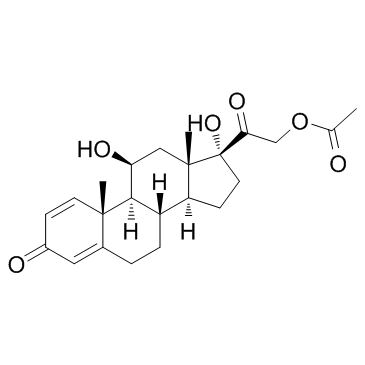Prednisolone Acetate

Prednisolone Acetate structure
|
Common Name | Prednisolone Acetate | ||
|---|---|---|---|---|
| CAS Number | 52-21-1 | Molecular Weight | 402.481 | |
| Density | 1.3±0.1 g/cm3 | Boiling Point | 579.8±50.0 °C at 760 mmHg | |
| Molecular Formula | C23H30O6 | Melting Point | 240-244 °C | |
| MSDS | Chinese USA | Flash Point | 198.4±23.6 °C | |
| Symbol |

GHS06 |
Signal Word | Danger | |
|
Development and validation of a new stability indicating reversed phase liquid chromatographic method for the determination of prednisolone acetate and impurities in an ophthalmic suspension.
J. Pharm. Biomed. Anal. 102 , 261-6, (2015) A new stability indicating reversed phase high performance liquid chromatography (RP-HPLC) method was developed and validated under current International Conference of Harmonisation (ICH) guidance for the determination of prednisolone acetate (PAC) and impuri... |
|
|
Convenient QSAR model for predicting the complexation of structurally diverse compounds with β-cyclodextrins
Bioorg. Med. Chem. 17 , 896-904, (2009) This paper reports a QSAR study for predicting the complexation of a large and heterogeneous variety of substances (233 organic compounds) with beta-cyclodextrins (beta-CDs). Several different theoretical molecular descriptors, calculated solely from the mole... |
|
|
Investigation of Overrun-Processed Porous Hyaluronic Acid Carriers in Corneal Endothelial Tissue Engineering.
PLoS ONE 10 , e0136067, (2015) Hyaluronic acid (HA) is a linear polysaccharide naturally found in the eye and therefore is one of the most promising biomaterials for corneal endothelial regenerative medicine. This study reports, for the first time, the development of overrun-processed poro... |
|
|
Topical cyclosporine a 1% for the treatment of chronic ocular surface inflammation.
Eye Contact Lens 40(5) , 283-8, (2014) To evaluate the use of topical cyclosporine A (CsA) 1% emulsion in the treatment of chronic ocular surface inflammation (OSI).We conducted a retrospective chart review of patients with various forms of OSI treated with topical CsA 1% from 2001 to 2012.Twenty-... |
|
|
Molecular characteristics for solid-state limited solubility.
J. Med. Chem. 51 , 3035-9, (2008) Solubility and solid-state characteristics were determined and multivariate data analysis was used to deduce structural features important for solid-state limited solubility of marketed drugs. Molecules with extended ring structures and large conjugated syste... |
|
|
Descemet's stripping automated endothelial keratoplasty with anterior chamber intraocular lenses: complications and 3-year outcomes.
Br. J. Ophthalmol. 98(8) , 1028-32, (2014) To describe outcomes and complications following Descemet's stripping automated endothelial keratoplasty (DSAEK) in eyes with pseudophakic bullous keratopathy (BK) while retaining the anterior chamber intraocular lenses (ACIOL).We included consecutive patient... |
|
|
Cystoid macular oedema following Descemet membrane endothelial keratoplasty.
Br. J. Ophthalmol. 99(1) , 98-102, (2015) To determine the incidence and potential risk factors of cystoid macular oedema (CMO) following Descemet membrane endothelial keratoplasty (DMEK) with or without simultaneous cataract surgery.In this study, 155 eyes of 88 patients suffering from Fuchs endothe... |
|
|
Using a collagen matrix implant (Ologen) versus mitomycin-C as a wound healing modulator in trabeculectomy with the Ex-PRESS mini glaucoma device: a 12-month retrospective review.
J. Glaucoma 23(9) , 649-52, (2014) To compare outcomes between patients undergoing trabeculectomy with an Ex-PRESS mini glaucoma device using mitomycin-C (MMC) to those undergoing the same procedure using a subconjunctival collagen matrix implant (Ologen).All patients underwent a trabeculectom... |
|
|
Deep Sclerectomy With a New Nonabsorbable Uveoscleral Implant (Esnoper-Clip): 1-Year Outcomes.
J. Glaucoma 24 , 421-5, (2015) To report the safety and the effectiveness of deep sclerectomy (DS) with a new nonabsorbable uveoscleral hema implant (Esnoper-Clip) designed to increase trabecular and uveoscleral outflow and to achieve higher intrascleral blebs.Twenty-seven eyes of 27 patie... |
|
|
In Vivo Confocal Microscopic Imaging of the Cornea After Femtosecond and Excimer Laser-assisted Penetrating Keratoplasty.
J. Refract. Surg. 31 , 620-6, (2015) To examine the microstructure of the cornea after excimer and femtosecond laser-assisted penetrating keratoplasty (ELAK and FLAK) in eyes with Fuchs' dystrophy and keratoconus.Fifty-seven patients were divided into four groups according to corneal disease and... |